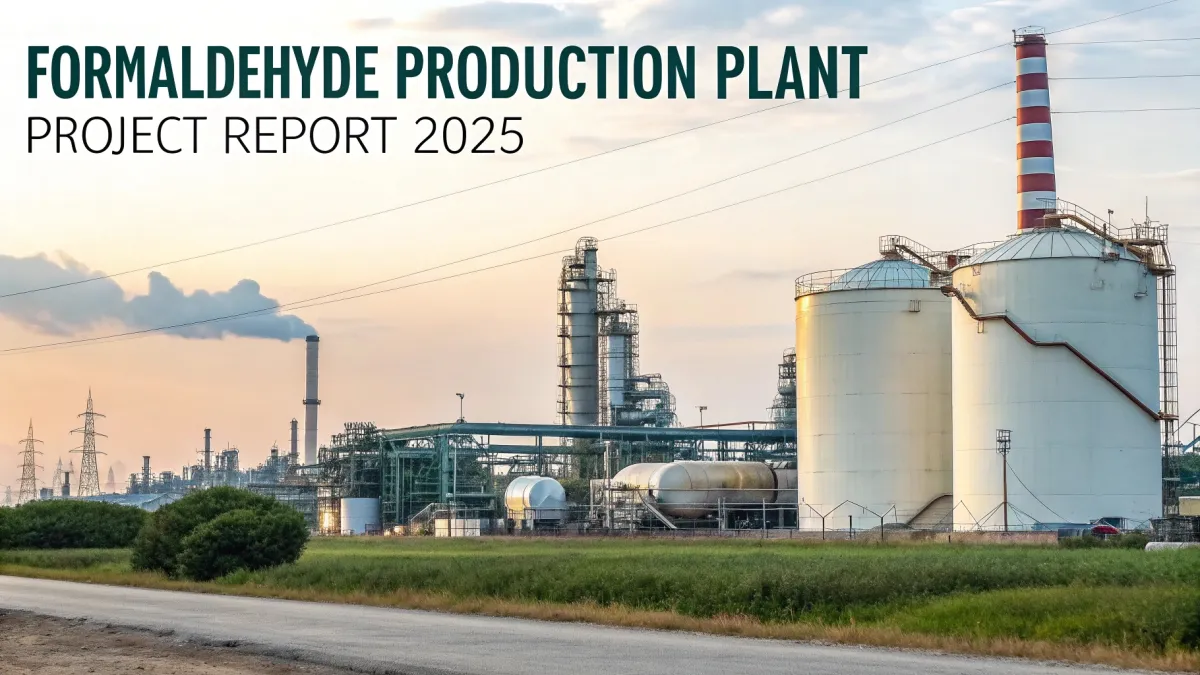
Formaldehyde Production Cost Analysis 2025: Project Details, Machinery Requirements & Industry Outlook
Setting up a formaldehyde production plant requires access to methanol feedstock, selection of silver or iron-molybdenum catalysts, and installation of reactors, absorption systems, and emission controls. Compliance with environmental and safety regulations is essential for operational approval.
IMARC Group's report, titled “ Formaldehyde Production Cost Analysis Report 2025: Industry Trends, Plant Setup, Machinery, Raw Materials, Investment Opportunities, Cost and Revenue,” provides a complete roadmap for setting up a formaldehyde production plant. It covers a comprehensive market overview to micro-level information such as unit operations involved, raw material requirements, utility requirements, infrastructure requirements, machinery and technology requirements, manpower requirements, packaging requirements, transportation requirements, etc.
Request for a Sample Report : https://www.imarcgroup.com/formaldehyde-manufacturing-plant-project-report/requestsample
Formaldehyde Industry Outlook 2025:
The formaldehyde industry outlook for 2025 remains positive, driven by sustained demand from construction, automotive, and textile sectors. Growth in urea-formaldehyde and phenol-formaldehyde resins continues to support production volumes, particularly in Asia-Pacific, which dominates global consumption. Increasing infrastructure development and rising use of engineered wood products further boost market prospects. However, environmental regulations and health concerns related to formaldehyde emissions may pose challenges, encouraging innovation in low-emission formulations and alternative technologies.
Key Insights for Formaldehyde Production Plant Setup:
Detailed Process Flow:
-
Product Overview
Unit Operations Involved
Mass Balance and Raw Material Requirements
Quality Assurance Criteria
Technical Tests
Project Details, Requirements and Costs Involved:
-
Land, Location and Site Development
Plant Layout
Machinery Requirements and Costs
Raw Material Requirements and Costs
Packaging Requirements and Costs
Transportation Requirements and Costs
Utility Requirements and Costs
Human Resource Requirements and Costs
Capital Expenditure (CapEx) and Operational Expenditure (OpEx) Analysis:
Project Economics:
-
Capital Investments
Operating Costs
Expenditure Projections
Revenue Projections
Taxation and Depreciation
Profit Projections
Financial Analysis
Profitability Analysis:
-
Total Income
Total Expenditure
Gross Profit
Gross Margin
Net Profit
Net Margin
Key Cost Components of Setting Up a Formaldehyde Plant :
-
Raw Material Procurement: Primary input costs, mainly for methanol and catalyst materials (silver or iron-molybdenum).
Plant and Equipment: Capital expenditure on reactors, absorbers, heat exchangers, control systems, and emission treatment units.
Technology Licensing and Engineering Design: Fees for process design, engineering consultancy, and technology transfer (if applicable).
Construction and Civil Works: Site preparation, building infrastructure, and utility installation (water, power, waste management).
Regulatory Compliance: Costs associated with environmental permits, safety systems, and adherence to local industrial regulations.
Labor and Training: Recruitment, salaries, and training of technical and operational personnel.
Operational Utilities: Ongoing costs for electricity, water, steam, and compressed air supply systems.
Logistics and Storage: Infrastructure for raw material storage, product handling, and distribution setup.
Economic Trends Influencing Formaldehyde Plant Setup Costs 2025 :
-
Volatility in Methanol Prices: Fluctuating global methanol prices, influenced by crude oil trends and supply-demand dynamics, directly impact raw material costs.
Inflationary Pressures: Rising global inflation affects construction materials, labor wages, and utility expenses, increasing capital and operational expenditures.
Interest Rate Environment: Higher interest rates in key economies elevate financing costs for plant construction and equipment procurement.
Regulatory Tightening: Stricter environmental and safety regulations in many regions necessitate additional investment in compliance technologies and pollution control systems.
Supply Chain Disruptions: Ongoing global logistics challenges contribute to delays and increased costs for importing machinery and raw materials.
Green Transition Investments: Growing demand for low-emission technologies encourages higher initial outlays for sustainable plant designs and cleaner production processes.
Regional Incentives: Government subsidies, tax breaks, and industrial policies in developing economies can offset setup costs and influence plant location decisions.
Browse the Full Report with the Table of Contents: https://www.imarcgroup.com/formaldehyde-manufacturing-plant-project-report
Challenges and Considerations for Investors in Formaldehyde Plant Projects:
-
Regulatory Compliance: Navigating complex environmental, safety, and health regulations is critical, particularly due to formaldehyde's classification as a hazardous substance.
Market Volatility: Demand fluctuations in downstream industries such as construction, automotive, and furniture can impact revenue stability.
Technological Selection: Choosing between silver-based or iron-molybdenum catalysts affects operational efficiency, capital cost, and environmental performance.
Capital Intensity: High initial investment requirements for infrastructure, equipment, and emission control systems may limit accessibility for small investors.
Environmental and Social Risks: Community resistance and environmental impact assessments may delay project approvals and require additional mitigation measures.
Raw Material Dependency: Reliance on methanol as the primary feedstock exposes operations to global commodity price swings.
Sustainability Pressures: Growing demand for eco-friendly materials may necessitate additional investment in low-emission technologies or alternative chemistries.
Skilled Workforce Availability: Recruiting and retaining qualified technical personnel is essential for efficient plant operation and safety management.
Conclusion:
In conclusion, investing in a formaldehyde production plant presents significant opportunities driven by steady demand across multiple industrial sectors. However, successful project execution requires careful consideration of regulatory compliance, capital investment, raw material sourcing, and technological choices. Navigating market volatility and addressing environmental concerns are critical to long-term viability. Strategic planning, risk mitigation, and alignment with sustainability trends will be essential for investors seeking to capitalize on growth potential in the formaldehyde industry.
About Us:
IMARC Group is a global management consulting firm that helps the world's most ambitious changemakers to create a lasting impact. The company excel in understanding its client's business priorities and delivering tailored solutions that drive meaningful outcomes. We provide a comprehensive suite of market entry and expansion services. Our offerings include thorough market assessment, feasibility studies, company incorporation assistance, factory setup support, regulatory approvals and licensing navigation, branding, marketing and sales strategies, competitive landscape, and benchmarking analyses, pricing and cost research, and procurement research.
Contact Us:
IMARC Group
134 N 4th St. Brooklyn, NY 11249, USA
Email: sales[@]imarcgroup.com
Tel No:(D) +91 120 433 0800
United States: (+1-201971-6302)
Legal Disclaimer:
MENAFN provides the
information “as is” without warranty of any kind. We do not accept
any responsibility or liability for the accuracy, content, images,
videos, licenses, completeness, legality, or reliability of the information
contained in this article. If you have any complaints or copyright
issues related to this article, kindly contact the provider above.


















Comments
No comment